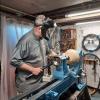This is my first attempt at anything on a lathe. Looks like it was attacked by a beaver with a toothache.
Started out as a 1-1/2" - 2" squarish piece of scrap pine. I used a 3/4" spindle roughing gouge. Lots of vibration. Fiddled with tool rest height trying various angles.
Manual said 2" or less diameter to rough at 1,000 or so RPM. Tried this, tried faster (~2,000 RPM), tried slower (~750 RPM). Nothing much made a difference.
2020-09-04 18.27.06.jpg
Thoughts?
PS Gouge was sharpened on a 180 grit 8" CBN wheel on low speed grinder on wolverine jig. Raised a burr, seemed to be sharp.






 Reply With Quote
Reply With Quote



